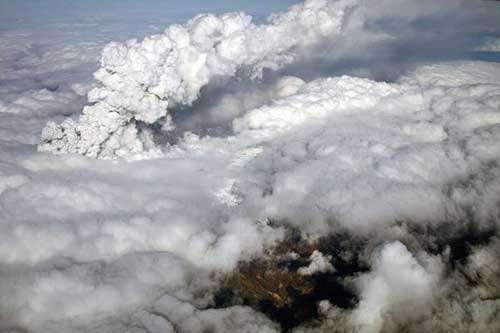Credit: NASA
(Phys.org)—It's well known that tropical-latitude volcanos have dramatic, global effects on atmosphere and climate. In fact, a new and startling book, Tambora: The Eruption That Changed the World, by Gillen D'Arcy Wood, documents the catastrophic eruption of the Tambora volcano in 1815, and the decade of climate change and global chaos that followed. Tamobora, a peninsula of the island of Sumbawa in Indonesia, is just such a tropical volcano.
By contrast, there has been less research into high-latitude volcanos, because their most obvious effects are perceived to be brief and hemispheric, rather than global. So questions remain about the long-term effects of these volcanos. A new study by an international collaborative of researchers, published in the Proceedings of the National Academy of Sciences, examines the long-term, ocean-mediated responses of high-latitude volcanos.
Using a pre-existing Earth system model that includes the treatment of the direct effect of atmospheric aerosols and the indirect effects of aerosols on warm clouds, as well as an updated ocean model, the researchers simulated a multistage, high-latitude volcanic eruption by injecting 100 Tg of SO2 and dust over a period of four months. The simulated eruption happens in 1934, in the middle of the 156-year historical period the researchers studied. The perturbations in climate were compared to the same 156-year cycle without a volcanic event.
The results show how large, summer high-latitude eruptions in the northern hemisphere trigger El Niño-like anomalies, relative to the no-volcano test case, in the first four to nine months after the event. These eruptions trigger hemispheric surface cooling which leads to a southward shift in the intertropical convergence zone, the zone near the equator where the northeast and southeast trade winds come together. In turn, this leads to a reduction in temperatures that favors the development of an El Niño-like anomaly.
But the volcanic event also brings long-term changes to two ocean circulation fronts: The Atlantic meridional overturning circulation (AMOC), and the El Niño–Southern oscillation (ENSO). In fact, the model demonstrated strong perturbations in these circulations for nearly a half-century following eruption. After a six-month weakening of AMOC, a progressive strengthening occurs, reaching its maximum around five to 10 years after the eruption, declining to a minimum at about 35 to 40 years after the eruption.
The results suggests that a cascade of effects from these AMOC changes affect ENSO variability, though this phenomenon is still not well understood. The authors write, "Physically, a stronger AMOC may cause an increase in ENSO variability by shoaling and flattening the Pacific thermocline along the equator, which enhances the strength of the Bjerknes feedback," the warm sea surface temperature anomalies accompanying a relaxation of trade winds.
Overall, the study's results demonstrate the potential for very large, high-latitude volcanic eruptions to affect the global climate through long-term changes in ocean circulation. The authors suggest that the development of further modeling studies at higher resolutions in the future might help to illuminate the AMOC-ENSO relationship and how the systems are affected by volcanic events.
More information: Impacts of high-latitude volcanic eruptions on ENSO and AMOC. PNAS 2015 ; published ahead of print October 26, 2015, DOI: 10.1073/pnas.1509153112
Abstract
Large volcanic eruptions can have major impacts on global climate, affecting both atmospheric and ocean circulation through changes in atmospheric chemical composition and optical properties. The residence time of volcanic aerosol from strong eruptions is roughly 2–3 y. Attention has consequently focused on their short-term impacts, whereas the long-term, ocean-mediated response has not been well studied. Most studies have focused on tropical eruptions; high-latitude eruptions have drawn less attention because their impacts are thought to be merely hemispheric rather than global. No study to date has investigated the long-term effects of high-latitude eruptions. Here, we use a climate model to show that large summer high-latitude eruptions in the Northern Hemisphere cause strong hemispheric cooling, which could induce an El Niño-like anomaly, in the equatorial Pacific during the first 8–9 mo after the start of the eruption. The hemispherically asymmetric cooling shifts the Intertropical Convergence Zone southward, triggering a weakening of the trade winds over the western and central equatorial Pacific that favors the development of an El Niño-like anomaly. In the model used here, the specified high-latitude eruption also leads to a strengthening of the Atlantic Meridional Overturning Circulation (AMOC) in the first 25 y after the eruption, followed by a weakening lasting at least 35 y. The long-lived changes in the AMOC strength also alter the variability of the El Niño–Southern Oscillation (ENSO).
Journal information: Proceedings of the National Academy of Sciences
© 2015 Phys.org






















